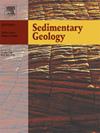Benthic response to event deposition and environmental disturbance in a shoreface to subaqueous delta system: Ichnology of the Silurian-Devonian Furada Formation of Asturias, Spain
IF 2.9
2区 地球科学
Q1 GEOLOGY
引用次数: 0
Abstract
The Furada Formation of Asturias, Spain, represents a clastic shallow-marine unit deposited during the middle Silurian to the Early Devonian. This formation contains abundant evidence of event deposition and non-uniform distribution of bioturbation structures representing a benthic response to multiple stressors. The 170-m-thick succession was measured and described, and the ichnotaxa were recorded and associated with five sedimentary facies. Most shallow-marine environments are characterized by periodic events of environmental disturbance, mainly by episodic deposition, which may be recorded by a change in both the degree of bioturbation and ichnodiversity. The general depositional setting for this formation has been previously interpreted as a wave-dominated and storm-influenced shallow-marine environment. However, sedimentologic features described in this study, such as anomalous heterolithic and mudstone units, representing fluid mud layers, hyperpycnal flow deposits and plume collapse accumulations, suggest the influence of fluvial discharge, making it a more complex depositional setting. The proposed model comprises an inner sandy shoreface belt flanked seawards by a muddy subaqueous delta platform. The trace-fossil assemblages of this formation reflect environmental stress factors introduced by the interplay of storms and fluvial input (e.g., high sedimentation rate, fluctuating hydrodynamic energy, decreased substrate consolidation), resulting in reduced ichnodiversity and low abundance. From an ichnofacies perspective, the shoreface complex is characterized by the Cruziana Ichnofacies, whereas the subaqueous delta platform is represented by the Phycosiphon Ichnofacies. Integration of sedimentologic and ichnologic datasets allows for a refined depositional interpretation of the formation and greater understanding of the environmental diversity of wave-and river-influenced shallow-marine clastic systems, including the responses of the middle Paleozoic shallow-marine benthos to event sedimentation and environmental disturbance. This study is one of the first detailed documentations of the ichnology of subaqueous deltas.
底栖生物对从海岸表面到水下三角洲系统的事件沉积和环境干扰的反应:西班牙阿斯图里亚斯志留纪-德文纪 Furada 地层的技术
西班牙阿斯图里亚斯的富拉达地层是志留纪中期至泥盆纪早期沉积的碎屑浅海单元。该地层包含大量事件沉积和非均匀分布的生物扰动结构的证据,代表了底栖生物对多种压力的反应。该研究对 170 米厚的演替进行了测量和描述,并记录了与五个沉积面相关联的ichnotaxa。大多数浅海环境的特点是周期性的环境扰动事件,主要是偶发性沉积,生物扰动程度和棘皮动物多样性的变化可记录这些扰动事件。该地层的总体沉积环境以前被解释为以波浪为主、受风暴影响的浅海环境。然而,本研究中描述的沉积特征,如代表流体泥层的异常杂岩和泥岩单元、超热液流沉积和羽流坍塌堆积,表明该地层受到了流体排放的影响,使其沉积环境更为复杂。所提出的模型包括一个内沙质海岸带,两侧是泥质水下三角洲平台。该地层的痕量化石组合反映了风暴和河流输入相互作用所带来的环境压力因素(如高沉积速率、水动力波动、基质固结度降低),从而导致生物多样性和丰度降低。从岩石结构的角度来看,海岸表层复合体的特征是 Cruziana 岩石结构,而水下三角洲平台则以 Phycosiphon 岩石结构为代表。通过整合沉积学和岩石学数据集,可以对该地层进行精细的沉积解释,并进一步了解受海浪和河流影响的浅海碎屑岩系统的环境多样性,包括中古生代浅海底栖生物对事件沉积和环境干扰的反应。这项研究是最早详细记录水下三角洲生态学的研究之一。
本文章由计算机程序翻译,如有差异,请以英文原文为准。
求助全文
约1分钟内获得全文
求助全文
来源期刊

Sedimentary Geology
地学-地质学
CiteScore
5.10
自引率
7.10%
发文量
133
审稿时长
32 days
期刊介绍:
Sedimentary Geology is a journal that rapidly publishes high quality, original research and review papers that cover all aspects of sediments and sedimentary rocks at all spatial and temporal scales. Submitted papers must make a significant contribution to the field of study and must place the research in a broad context, so that it is of interest to the diverse, international readership of the journal. Papers that are largely descriptive in nature, of limited scope or local geographical significance, or based on limited data will not be considered for publication.
 求助内容:
求助内容: 应助结果提醒方式:
应助结果提醒方式:


